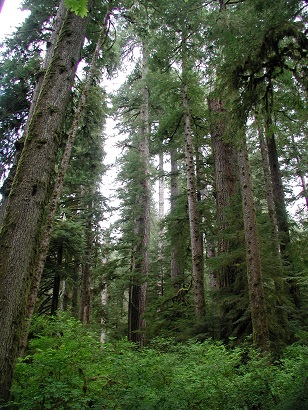Brad Withrow-Robinson, OSU Forestry & Natural Resources Extension agent for Benton, Linn and Polk counties.

People enjoy and cherish Oregon’s forests for a number of reasons. High among them are the beauty and the variety of plants and animals that live there.
While most of us picture older forests when we read that, we would be wrong to think of that as the complete picture. Nonetheless a large part of our emotional, scientific and social energy is directed towards those older forests.
I recently attended a workshop and tour that focused on another stage of forest development. A stage that many people would not recognize as, or even call a forest. It is the often-unsightly mix of living and dead that is left after a major disturbance like a wild fire, or a clearcut harvest. Where trees once stood, stumps, snags, brush and weeds prevail.

Ecologists call this stage “Early Seral” forests.
I think of them as “Forests on the Rebound”.
But some might ask “if a forest has been destroyed by fire or harvest how can it be said to be rebounding?”
Despite the scarred appearance and loss of the forest tree canopy, it is important to recognize that these forests have been disturbed, not destroyed. Yes, most of the trees are gone but the sites still contain many critical parts, legacies of the previous forest stage. Shrubs such as snowberry, salal and vine maple, trees like chinkapin and bigleaf maple, and many flowering herbs and grasses will all quickly resprout and flourish in the open sunshine. Other trees and shrubs which propagate by seed also often quickly establish, even if it takes several years to be recognizable. Trees which have to re-seed include red alder, Douglas-fir, hemlock and western redcedar. So, many (though not nearly all) of the plants that were there before are generally still there a short while after the disturbance. This often sets the stage for a similar forest to rebound and eventually reoccupy that site.

These rebounding forests are often super-diverse. Not only do they contain the plant legacies from the earlier forest, they quickly collect many other new, sun-loving species of plants that were not part of the previous forest. These new additions emerge from the seed bank or drift in on the wind to take advantage of the sunny new environment on the forest floor. This is the recipe for great plant diversity.
These new, radically different forest conditions are exactly what many animals need, too. A whole host of animals are keyed in to, and dependent on this stage of rebounding forests. Deer and elk, migratory songbirds and bats, pollinating bees and butterflies all flourish among the rowdy, diverse vegetation of the rebounding forest. Important species that help illustrate the importance of this forest stage.
There is new research trying to understand the role forest plantations play in providing habitat to animals who depend on these early seral habitats for their success. More on that in the next post.
